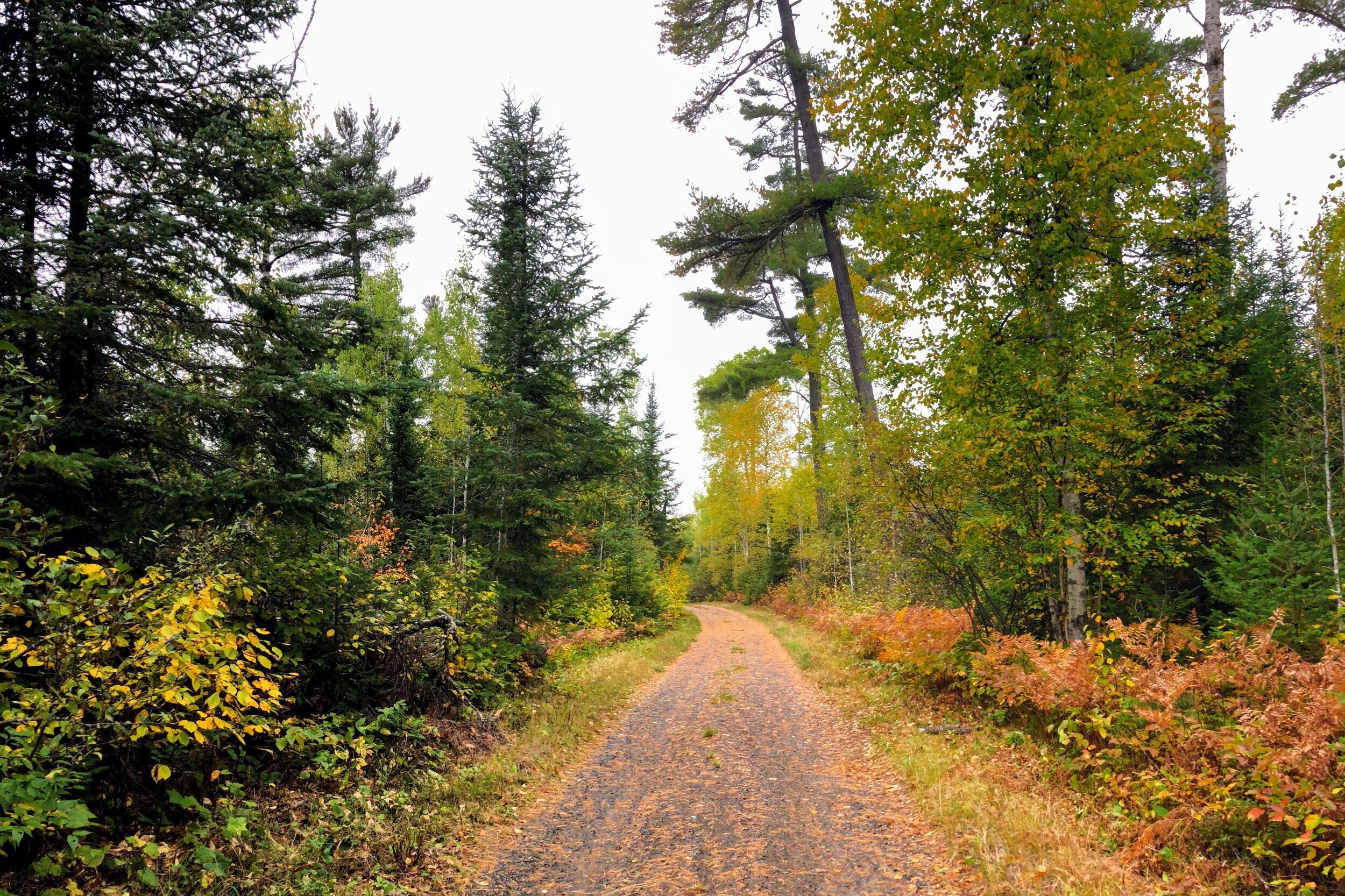The Thread
In Drinking from the River of Light, Mark Nepo asks the reader to define for themselves “The Thread”—the thing that stays constant throughout one’s life, something they hold on to as circumstances around them shift, something that helps them connect the dots of all of their experiences to create a narrative that helps them make meaning of their lives. To discover this thread, he says “is the main reason to listen, express, and write.”
When I first read it, I puzzled over the question. It seemed too vague, and answers like “family” or “art” were cliche and didn’t sit well. So I kept reading the book and forgot about the question, until that night I was driving down the Gunflint Trail, coming home from “town” (what Gunflint Trail residents call Grand Marais, the closest town for those who live here). It was autumn, and getting to the time of year when night falls early and hard. Driving after sundown, the dark gathers from miles of unlit, wild Superior National Forest and presses down on you from all sides. High beams hardly penetrate it. Sometimes, the haunch of a moose materializes, as black as the night, or the surprise eye-flash of a fox offers the only other light around for miles and miles. This is, after all, one of the darkest places on Earth.
I have memorized the 30-ish miles of this road from town to the place I live and work. I drive it at least weekly to get groceries, go to the library, fill up on gas, see friends. That doesn’t sound remarkable—after all, in the city I also drove one road daily to get to work—but the Gunflint Trail doesn’t have the typical traffic jams and construction changes of other roads. Usually, there are hardly any cars to contend with, leaving space to actually notice the road itself. I’ve come to know every curve, bump, and dead tree protruding overhead. Once, at a recent gathering with friends, someone mentioned “that big bump after the big curve” and all of us who live here knew exactly what spot he meant.
And yet, that night driving home in the late fall deep dark, I spaced out as one does when driving a familiar road, and when I came to, I couldn’t remember exactly how far I’d gone, or which balsam trees were reflected back at me by my brights. Was I fifteen miles out from home, or five? My brain offered, “You lost the Thread.” And, ah, there it was. My Thread.
Great Beauty, Great Extremes
The image of the Gunflint Trail as a thread snaking through the wilderness is an apt one. For those not familiar with this special road, the Gunflint Trail is a 57-mile long scenic byway leading from the small town of Grand Marais, MN into the Superior National Forest and ending, essentially, in a lake. It is used as a gateway into the Boundary Waters Canoe Area Wilderness, a 1 million + acre protected area of beautiful lakes, rivers, and boreal forest. (I’d like to acknowledge that the original owners of this area are the Anishinaabe (sometimes referred to as Ojibwe or Chippewa.) I invite you to read more about how this area was ceded to the US government, and treaty rights, here.) Along the way are businesses like campgrounds, camps, cabins, bed and breakfasts, and lodges, one of which I began working at in 2017, which is how I landed in this unique place.
Though the area is remote and wild, these businesses create little pockets of people who are here year-round to serve the thousands of tourists that visit in peak summer (to camp, canoe, and vacation) and winter (to ski, snowmobile, and ice fish) and who stick it out through the often depressing “off-season” when the roads are melting into sodden puddles or a foot of snow is coming down in MAY. It’s a tough life, and many hardy folks have powered through season after season for their entire lives.
I can’t claim that sort of toughness (yet!), but there is a sort of pride that comes with being one of the few who choose to live on the Gunflint Trail all year. (I read once that only around 70 people live year-round on the Gunflint Trail, with an influx of seasonal residents who come to work at lodges and outfitters during peak times.) The Gunflint is its own small town in a way, with each little populated section of the road its own subculture within the greater Trail culture. There are age-old stories, long-lasting friendships, friendly competition, businesses that have been in the same family for generations, lots of gossip, and, I was surprised and pleased to find, a few other young-ish people also choosing to make a life here, making good friends another benefit of being here for the long haul.
Beyond the human factors, the Gunflint Trail is a place of great beauty and great extremes. Rugged white pines that survived the early 20th century logging boom tower over the aspen, birch, and balsam. Pristine lakes dominate the landscape. Rocky terrain makes for good hiking and stunning vistas. And yet. The winters usually last six to seven months. It has been known to snow in June and frost in August. In summer, the bugs are voracious, different species taking their turn during different months, ensuring that the entire summer is blanketed by a constant threat of being bitten, stung, and scarred. Black bear, wolf, moose, lynx, bobcat, fox, deer, marten, hare, squirrel, chipmunk, mice, and a variety of birds and other beasts offer additional excitement by living their lives adjacent to us and allowing the occasional sighting. Winter temperatures regularly get down to -30 F (and that’s without windchill, which gets down to -55 F). It becomes a sport to look up the weather in Antarctica and the North Pole to see how the Gunflint compares—and it’s often colder here than there. And yet I always say this is the best way to spend a Minnesota winter: they’re always long and cold, but at least here, I can strap on my skis and ski right out my front door onto miles of snowy, perfectly groomed trails through the trees.
The Thread
Part of my decision to move here from “the cities” (Minneapolis-St. Paul area) was because though I loved St. Paul, with its old buildings, quiet streets, and towering elms, I longed to put down roots somewhere with more natural beauty. I wanted to live in a place I could identify with, and that could inform my identity. The northeastern part of Minnesota — I will at various times call it the North Shore, the northwoods, the Arrowhead, Cook County — had already been that for me at various times in my life. I’d grown up camping in the area with my family, and at one point we owned 40 acres near the North Shore of Lake Superior. This land that only contained trees, streams, and beaver ponds always, even as a kid, raised a sense of belonging in me. I wanted to stay forever. In college, I worked at a lodge on the Gunflint Trail (which I eventually called up seven years later to see if they had a job for me, and at which I have been living and working for the better part of three years) and after graduating, I did a year in the Conservation Corps in Tofte, MN, giving me a taste of what it was like to spend a whole year in the northwoods, working outdoors, watching the seasons change, watching myself change with them.
And yet a variety of circumstances sent me back to the cities, principally health and financial reasons, in addition to the sense of urgency felt by someone recently out of school to find and begin and excel at a career. And so, I did those things. It was good and hard just as life here is, yet the backdrop wasn’t quite right. I began to feel stagnant, and for me, small changes aren’t enough to get me out of a rut. I convince myself that the only way to change is to change everything. I needed to move.
And so, partway into 2017, I did. But don’t get me wrong, it wasn’t like everything aligned to make it convenient to quit my job with good health insurance and move to the woods. There were many obstacles, indecision, insomnia, anxiety, and pain from the time I was struck by the urge to go and when I actually left. I was a person with a chronic illness about to go into the health insurance market at the exact time the new president was trying very, very hard to repeal the Affordable Care Act, which I would need. It was quite risky to go. But once the idea took root in me, I couldn’t ignore it. For the first time in a long time, I felt excited. But there was a sort of desperation to the excitement. I was almost manic with desire for change, scribbling in notebooks about what my days would look like in my new life, tossing and turning at night wondering if the pieces would fall into place. And then in June 2017, when I’d managed to make this dream a reality and was squeezing into my tiny car packed to the brim with all of my belongings, I was bereft. Why was I leaving my friends and family? Why couldn’t I be satisfied in my comfortable-yet-stagnant existence? Why did I have to make everything so hard?
The answers, while still unfolding even now, began to reveal themselves when I landed, uncertain and scared, in the place I’d always dreamed of living. Lake out my front door, a backyard made of gravel roads through brush and trees. The answers were in swimming in that lake, in wandering those roads, in skiing the trails and ice skating on frozen lakes. The answer to the bigger question I am addressing here—Nepo’s question about “the thread that runs through everything”—was also in those places, in doing those things.
That is, a Sense of Place is my “Thread.” The Place I live or the Place I long to live becomes a driving force in my decisions, what anchors me in myself, a core part of my identity, and, as a result, a core part of whatever I am making, whether it be writing or weaving or whatever else I might make in the future. It is why so many of my weaving designs reflect the nature around me, and why I insist upon photographing them outside, no matter how impractical. The Place doesn’t have to be the Gunflint Trail, and it might not be forever, but it is right now, and goddamn, it is magnificent.











